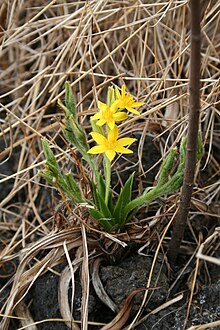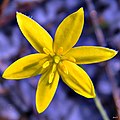Hypoxis
| Hypoxis Temporal range: Pliocene - recent
| |
|---|---|

| |
| Scientific classification | |
| Kingdom: | Plantae |
| Clade: | Tracheophytes |
| Clade: | Angiosperms |
| Clade: | Monocots |
| Order: | Asparagales |
| Family: | Hypoxidaceae |
| Genus: | Hypoxis L. |
| Synonyms[1] | |
| |
Hypoxis is a genus of flowering plants of the family Hypoxidaceae. The genus has an "almost cosmopolitan" distribution, occurring in Africa, the Americas, Asia, and Australia.[2] Europe lacks native species.[3] Most species are in the Southern Hemisphere, especially in southern Africa.[4] Common names for the genus include star-grass,[4] star lily, yellow stars, African potato,[2] and stars.[5] The genus is the largest of the Hypoxidaceae[6][7] and has its centre of variation in South Africa,[6][8][9] where it occurs in open undisturbed grasslands.[8] The name Hypoxis was taken over by Linnaeus in 1759 from a name coined by in 1611 for a superficially similar species of Gagea and meaning "a little sour", referring to the taste of that plant's leaves.[10][11]
Description[]
These plants are perennial herbs with corms or rhizomes. Some have tubers. The aboveground herbage is a layered cluster of lance-shaped, linear, or hairlike leaves, sometimes sheathed together at the bases. The blades are usually at least slightly hairy. The flowers are borne on a short, stemlike scape in a raceme or umbel arrangement, or sometimes singly. The flower has six yellow tepals which may be hairy, especially on the undersides. The undersides may also be whitish or tinged green or red. Occasional flowers have 4 or 8 tepals. The fruit is a capsule with a few to many small, oily seeds.[2][4][5]
The seeds are needed to identify many species. Most have seeds less than 2 millimeters long, so microscopic examination is required.[12]
Uses[]
Hypoxis plants have long played a role in traditional African medicine; H. hemerocallidea and H. colchicifolia are the best known species used to make medicine and teas. The genus is not only used in traditional medicine, it has become important also in pharmaceutical preparations.[13]
Archaeological evidence found in ashes in Border Cave, South Africa has revealed that early humans roasted the rhizomes of some of the more palatable species of Hypoxis as long as 170,000 years ago.[14]
Species[]
Sources have estimated 90[2][12] or 100[4] to 150[15] species in the genus. As of August 2013, the World Checklist of Selected Plant Families recognized 90 species:[16]
- Hochst.
- Baker
- Lam.
- Harv. ex Baker
- R.J.F.Hend.
- Lour.
- Wiland
- Baker
- Baker
- Brackett
- Baker
- Sánchez-Ken[17]
- Baker
- Welw. ex Baker
- Rose in J.K.Small – Curtiss' star-grass
- Hypoxis decumbens L.
- Nel
- Nel
- Urb.
- Nel
- R.J.F.Hend. – swamp star
- Baker
- Pax
- Baker
- Baker
- Baker
- R.J.F.Hend.
- Baker
- R.Br. – star grass, tiny star
- Harms
- Rendle
- Hypoxis hemerocallidea Fisch. – African potato
- Hypoxis hirsuta (L.) Coville – common goldstar
- Kunth
- Hypoxis hygrometrica Labill. – golden weather-glass
- Nel
- Hypoxis juncea Sm. – fringed yellow star-grass
- Baker
- Buchinger ex C.Krauss
- Nel
- Wiland
- Fritsch
- B.L.Burtt
- Baker
- McVaugh
- Baker
- Wiland
- Wiland
- R.Br.
- Baker
- Hypoxis mexicana Schult. & Schult.f. – Mexican yellow star-grass
- Baker
- Wiland
- Buchinger ex Baker
- Schinz
- R.J.F.Hend.
- Y.Singh
- Baker
- Nel
- Burch. ex Ker Gawl.
- Benth.
- Baker
- Baker
- Baker
- Welw. ex Baker
- Brackett
- R.Br.
- Nel
- G.L.Nesom
- Chapm.
- Baker
- Nel
- Nel
- M.Lyons & Keighery
- Baker
- L.
- Baker
- Jacq.
- Ker Gawl.
- Nel
- Wiland
- Brackett
- Hilliard & B.L.Burtt
- Markötter
- Wiland
- Nel
- Schltdl. – yellow star
- Hypoxis villosa L.f.
- (Baker) Brackett
- Baker
Gallery[]
References[]
| Wikimedia Commons has media related to Hypoxis. |
- ^ Kew World Checklist of Selected Plant Families
- ^ Jump up to: a b c d Singh, Y. (Natal Herbarium, Durban). Hypoxis. PlantZAfrica.com: South African National Biodiversity Institute. 2004.
- ^ Hypoxis. Flora of China.
- ^ Jump up to: a b c d Hypoxis. Flora of North America.
- ^ Jump up to: a b Hypoxis. FloraBase. Western Australian Herbarium.
- ^ Jump up to: a b Singh, Y. (2007-07-01). "Hypoxis (Hypoxidaceae) in southern Africa: Taxonomic notes". South African Journal of Botany. 73 (3): 360–365. doi:10.1016/j.sajb.2007.02.001.
- ^ Kocyan, Alexander; Snijman, Deirdre A.; Forest, Félix; Devey, Dion S.; Freudenstein, John V.; Wiland-Szymańska, Justyna; Chase, Mark W.; Rudall, Paula J. (2011-07-01). "Molecular phylogenetics of Hypoxidaceae – Evidence from plastid DNA data and inferences on morphology and biogeography". Molecular Phylogenetics and Evolution. 60 (1): 122–136. doi:10.1016/j.ympev.2011.02.021. PMID 21459153.
- ^ Jump up to: a b Nordal, Inger; Laane, Morten M.; Holt, Ellen; Staubo, Inger (1985-02-01). "Taxonomic studies of the genus Hypoxis in East Africa". Nordic Journal of Botany. 5 (1): 15–30. doi:10.1111/j.1756-1051.1985.tb02067.x. ISSN 1756-1051.
- ^ Wiland-Szymańska, Justyna (2009). "The genus Hypoxis L. (Hypoxidaceae) in the East Tropical". Biodiversity: Research and Conservation. 14 (–1): 1–129. doi:10.2478/v10119-009-0011-5.
- ^ Paul Reneaulme. Specimen Historiae Plantarum. 1611. page 92
- ^ Drewes and Khan (2004). "The African Potato (Hypoxis hemerocallidea): a chemical historical perspective". South African Journal of Science.
- ^ Jump up to: a b Zona, S.; et al. (2009). "A seed atlas of Hypoxis from eastern North America" (PDF). J. Torrey Bot. Soc. 136 (1): 26–32. doi:10.3159/08-ra-086r.1. Archived from the original (PDF) on 2013-12-19. Retrieved 2013-08-19.
- ^ Betto, P.; Gabriele, R.; Galeffi, C. (1992-03-06). "Determination of the norlignan glucosides of Hypoxidaceae by high-performance liquid chromatography". Journal of Chromatography A. 594 (1): 131–135. doi:10.1016/0021-9673(92)80321-K.
- ^ Wadley, L.; Backwell, L.; d'Errico, F. (2020-01-03). "Cooked starchy rhizomes in Africa 170 thousand years ago". Science. 367 (6473): 87–91. doi:10.1126/science.aaz5926. PMID 31896717.
- ^ Genus Hypoxis. New South Wales Flora Online. National Herbarium. Royal Botanic Garden, Sydney.
- ^ Search for "Hypoxis", "World Checklist of Selected Plant Families". Royal Botanic Gardens, Kew. Retrieved 2013-08-19.
- ^ Sánchez-Ken, J. G. (2010). "Hypoxis colliculata (Hypoxidaceae), a new species from Mexico and a key to the American species with black seeds" (PDF). Acta Botanica Mexicana. 92 (92): 1–9. doi:10.21829/abm92.2010.280.
External links[]
- Hypoxis. Red List of South African Plants. SANBI.
- GRIN Species Records of Hypoxis. Germplasm Resources Information Network (GRIN).
- Hypoxis. ITIS.
- Hypoxis
- Asparagales genera


